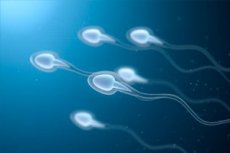Nye publikasjoner
En lovende tilnærming til utvikling av p-piller for menn
Sist anmeldt: 02.07.2025

Alt iLive-innhold blir gjennomgått med medisin eller faktisk kontrollert for å sikre så mye faktuell nøyaktighet som mulig.
Vi har strenge retningslinjer for innkjøp og kun kobling til anerkjente medieområder, akademiske forskningsinstitusjoner og, når det er mulig, medisinsk peer-evaluerte studier. Merk at tallene i parenteser ([1], [2], etc.) er klikkbare koblinger til disse studiene.
Hvis du føler at noe av innholdet vårt er unøyaktig, utdatert eller ellers tvilsomt, velg det og trykk Ctrl + Enter.

I løpet av de siste 60 årene har verdens befolkning økt mer enn 2,6 ganger. Denne veksten fortsetter – prognoser viser at befolkningen vil nå 9 milliarder innen 2037, opp fra 8 milliarder i 2022. Disse tallene understreker behovet for familieplanlegging; prevensjonsgjennombrudd har imidlertid vært få de siste tiårene. Dette gjelder spesielt for menn, som det ennå ikke er utviklet p-piller for.
I en studie publisert i tidsskriftet Science viste forskere fra Baylor College of Medicine og kolleger i dyremodeller at en ny, ikke-hormonell, sædspesifikk metode tilbyr et lovende alternativ for reversibel prevensjon for menn.
«Til tross for at forskere har jobbet med mannlige prevensjonsmidler i lang tid, har vi fortsatt ingen p-piller for menn», sa hovedforfatter av studien, Dr. Martin Matsuk, direktør for Center for Drug Discovery og leder for avdelingen for patologi og immunologi ved Baylor College of Medicine.
"I denne studien fokuserte vi på en ny tilnærming – å finne et lite molekyl som ville hemme serin/treoninkinase 33 (STK33), et protein som er essensielt for fruktbarhet hos både menn og mus."
Tidligere studier har vist at STK33 spiller en nøkkelrolle i dannelsen av funksjonelle sædceller. Mus der Stk33-genet var slått av var infertile på grunn av unormal sædkvalitet og dårlig sædmotilitet. Hos menn fører STK33-genmutasjonen også til infertilitet av samme årsaker. Det er viktig å merke seg at disse musene og mennene ikke har andre defekter, og størrelsen på testiklene forblir normal.
«STK33 ser ut til å være et lovende mål for mannlig prevensjon med minimale sikkerhetsbekymringer», sa Matsuk, som har vært ved Baylor College of Medicine i 30 år og har flere prestisjefylte stillinger.
Å finne en potent STK33-hemmer «Vi brukte DNA-kodet kjemi (DEC-Tec)-teknologi for å screene samlingen vår av flere milliarder forbindelser og oppdage potente STK33-hemmere», sa studiens førsteforfatter, Dr. Angela Ku, en postdoktor i Matsuka-laboratoriet. «Vi og andre grupper har brukt denne tilnærmingen for å oppdage potente og selektive kinasehemmere.»
Forskerne fant potente STK33-hemmere og laget modifiserte versjoner av dem for å gjøre dem mer stabile, potente og selektive. «Blant disse modifiserte versjonene var CDD-2807 den mest effektive», la Ku til.
«Vi testet deretter effekten av CDD-2807 i vår musemodell», sa studiens medforfatter Dr. Courtney M. Sutton, en postdoktor i Matsuk-laboratoriet. «Vi evaluerte flere doser og behandlingsplaner, og bestemte deretter musenes sædmotilitet og antall, samt deres evne til å befrukte hunner.»
Legemidlet CDD-2807 krysset effektivt blod-testis-barrieren og reduserte sædmotilitet, sædkvalitet og fertilitet hos mus ved lave doser. «Vi var glade for å se at musene ikke viste tegn til toksisitet fra CDD-2807-behandling, legemidlet akkumulerte seg ikke i hjernen, og behandlingen endret ikke testikkelstørrelsen slik den gjorde hos Stk33 knockout-mus og STK33-mutantmenn», bemerket Sutton.
«Det viktige poenget var at den prevensjonelle effekten var reversibel. Etter at man sluttet med CDD-2807, ble sædmotiliteten og -tallet gjenopprettet hos musene, og de ble fruktbare igjen.»
"I vår artikkel presenterer vi også den første krystallstrukturen til STK33," sa studiens medforfatter Dr. Choel Kim, førsteamanuensis i biokjemi og molekylær farmakologi og medlem av Dan L. Duncan Comprehensive Cancer Center ved Baylor College of Medicine.
"Krystallstrukturen vår viste hvordan en av våre potente hemmere samhandler med STK33-kinasen i tre dimensjoner. Dette tillot oss å modellere og designe vårt endelige legemiddel, CDD-2807, med bedre legemiddelegenskaper."
«Denne studien var et virkelig gjennombrudd for teamet vårt ved Baylor Drug Discovery Center og våre samarbeidspartnere», sa medforfatter av studien, Dr. Minxing Teng, assisterende professor i patologi og immunologi og biokjemi og molekylær farmakologi ved Baylor College of Medicine. Teng er også forsker ved Texas Cancer Research Institute og medlem av Dan L. Duncan Comprehensive Cancer Center ved Baylor.
"Ved å starte med et genetisk validert prevensjonsmål, kunne vi vise at STK33 også er et kjemisk validert prevensjonsmål."
«I de kommende årene er målet vårt å evaluere denne STK33-hemmeren og forbindelser som CDD-2807 videre hos primater for å bestemme deres effekt som reversible prevensjonsmidler for menn», konkluderte Matsuk.
